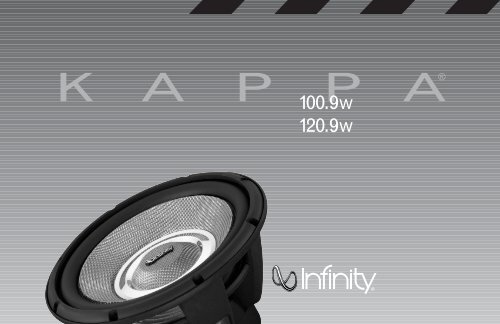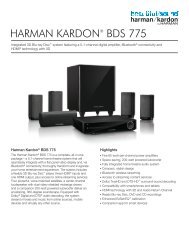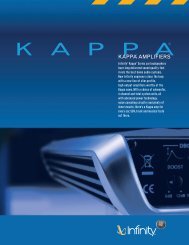Download - Infinity
Download - Infinity
Download - Infinity
Create successful ePaper yourself
Turn your PDF publications into a flip-book with our unique Google optimized e-Paper software.
K A P P A®<br />
100.9w<br />
120.9w
2<br />
®<br />
KAPPA<br />
THANK YOU for choosing an<br />
<strong>Infinity</strong> ® Kappa ® Series 100.9w or 120.9w<br />
subwoofer.These Kappa subwoofers are<br />
designed to suit a broad range of car audio<br />
applications and can be used in a wide<br />
variety of enclosure types to produce<br />
extended, powerful bass in a limited<br />
amount of vehicle space.To get the most<br />
performance from your new subwoofer,<br />
it is strongly recommended that you have<br />
a qualified professional install your 100.9w<br />
or 120.9w subwoofer. Although this manual<br />
does provide general instructions about<br />
installing these Kappa Series subwoofers,<br />
it does not include enclosure construction<br />
details or exact installation methods for<br />
any particular vehicle. If you do not feel<br />
that you have the necessary experience,<br />
do not attempt the installation yourself, but<br />
instead ask your authorized <strong>Infinity</strong> dealer<br />
about professional installation options.<br />
Remember to keep your sales receipt in a<br />
safe place, along with this manual, so that<br />
both are available for future reference.<br />
BOX CONTENTS<br />
(1) 100.9w or 120.9w subwoofer<br />
(1) Foam mounting gasket<br />
(1) 3mm hex wrench<br />
(1) Owner’s manual<br />
(1) Technical data sheet<br />
WARNING<br />
Playing loud music in a vehicle can hinder<br />
your ability to hear traffic and permanently<br />
damage your hearing.The maximum volume<br />
levels achievable by <strong>Infinity</strong> speakers when<br />
combined with high-power amplification<br />
may exceed safe levels for extended<br />
listening. Using low volume levels is<br />
recommended when driving. <strong>Infinity</strong><br />
Systems accepts no liability for hearing<br />
loss, bodily injury, or property damage as<br />
a result of use or misuse of this product.<br />
REPRODUCING<br />
BASS IN VEHICLES<br />
Depending on the size of your vehicle’s<br />
interior listening space, reproduced bass<br />
frequencies below 80Hz will be boosted<br />
by nearly 12dB per octave as frequency<br />
decreases.This phenomenon, known as the<br />
vehicle’s transfer function (or cabin gain),<br />
plays an important role in shaping the<br />
subwoofer’s frequency response in your<br />
vehicle.The enclosed technical data sheet<br />
includes frequency response graphs that<br />
show both the subwoofer’s “in-car”<br />
response (which factors in this vehicle<br />
transfer function) and its “out-of-car”<br />
response (which does not).
SUBWOOFER<br />
ENCLOSURE TYPES<br />
Kappa 100.9w and 120.9w subwoofers are<br />
designed to perform best in moderately<br />
sized sealed enclosures, vented enclosures<br />
and prefabricated band-pass enclosures.<br />
Infinite-baffle mounting is possible, but the<br />
subwoofer’s mechanical power handling will<br />
be reduced because there will be no volume<br />
of air to stiffen the subwoofer’s suspension<br />
and prevent overexcursion. If you choose<br />
infinite-baffle mounting, consider the RMS<br />
and peak power-handling ratings to be half<br />
of what is listed in the specifications in<br />
this manual.<br />
You should choose an enclosure type<br />
based on the amount of cargo space you<br />
can devote to the enclosure, the amount<br />
of power you will use to drive your<br />
subwoofer(s), and your listening habits.<br />
SEALED ENCLOSURES<br />
The air trapped inside a sealed enclosure<br />
is compressed when the subwoofer<br />
moves rearward and is rarefied when the<br />
subwoofer moves forward. In both cases,<br />
the air inside and outside the box will<br />
seek equilibrium by pushing and pulling<br />
on the subwoofer cone.The result is a<br />
stiffer suspension when compared to the<br />
subwoofer operating in free air.This means<br />
that the subwoofer’s cone will be harder<br />
to move at low frequencies, a condition<br />
which protects the subwoofer from<br />
physical overexcursion, but requires more<br />
power than other designs to achieve a<br />
given acoustic output.<br />
See accompanying data sheet for specific<br />
enclosure dimension requirements.<br />
SEALED-ENCLOSURE PERFORMANCE ADVANTAGES<br />
• The in-vehicle performance will have<br />
the flattest overall frequency response.<br />
• The in-vehicle response will have the<br />
widest bandwidth. (Usable low-frequency<br />
response inside the vehicle will be<br />
below 20Hz.)<br />
• An optimum sealed enclosure will always<br />
be smaller than an optimum enclosure of<br />
another type.<br />
SEALED-ENCLOSURE PERFORMANCE TRADE-OFFS<br />
• An optimum sealed enclosure will have<br />
lower overall efficiency than an optimum<br />
enclosure of another type.<br />
• A 100.9w or 120.9w subwoofer in an<br />
optimum sealed enclosure will require<br />
more amplifier power to achieve a given<br />
acoustic output than in an optimum<br />
enclosure of another type.<br />
SEALED-ENCLOSURE CONSTRUCTION<br />
Sealed-enclosure construction is straightforward<br />
and forgiving of errors in volume<br />
calculation, but air leaks should be avoided.<br />
Use medium-density fiberboard (MDF), glue<br />
and screws to construct the enclosure, and<br />
seal all joints with silicone caulk.<br />
THE INFINITY RECOMMENDATION<br />
100.9w and 120.9w subwoofers in sealed<br />
enclosures are recommended for enthusiasts<br />
who prefer accurate music reproduction<br />
and flat frequency response, for those<br />
who have a smaller space to devote to a<br />
subwoofer enclosure, and for those who<br />
have plenty of amplifier power devoted to<br />
driving the subwoofer.The sealed-enclosure<br />
design indicated on the technical data sheet<br />
accompanying this manual represents the<br />
best compromise between low-frequency<br />
extension and flat response.<br />
3
4<br />
®<br />
KAPPA<br />
VENTED ENCLOSURES<br />
A vented enclosure acts like a sealed<br />
enclosure at frequencies above its tuned<br />
(resonance) frequency. At resonance (which<br />
is defined by the vent), the vent produces<br />
the majority of sound – the subwoofer cone<br />
is nearly stationary while the air inside<br />
the vent vibrates.This provides greater<br />
mechanical power handling at and above<br />
resonance, but reduced mechanical power<br />
handling below resonance. Since the<br />
subwoofer cone and voice coil don’t move<br />
much at resonance, airflow across the<br />
voice coil is minimized and thermal power<br />
handling is reduced slightly at resonance.<br />
Vented enclosures provide better efficiency<br />
in the 40Hz – 60Hz range, at the expense of<br />
sound output in the lowest octave (below<br />
40Hz).The use of an infrasonic filter is<br />
recommended with vented enclosures.<br />
An optimum vented enclosure for a Kappa<br />
Series subwoofer is larger than an optimum<br />
sealed enclosure.<br />
See accompanying data sheet for specific<br />
enclosure dimension requirements.<br />
VENTED-ENCLOSURE PERFORMANCE ADVANTAGES<br />
• An optimum vented enclosure has greater<br />
efficiency and higher output in the<br />
40Hz – 60Hz range than an optimum<br />
sealed enclosure.<br />
• An optimum vented enclosure provides<br />
a greater sensation of bass than an<br />
optimum sealed enclosure.<br />
• A 100.9w or 120.9w subwoofer in an<br />
optimum vented enclosure will require<br />
less amplifier power to achieve a given<br />
acoustic output (down to the enclosure’s<br />
resonance frequency) than in an optimum<br />
sealed enclosure.<br />
VENTED-ENCLOSURE PERFORMANCE TRADE-OFFS<br />
• Reduced output in the lowest octave<br />
(below 40Hz).<br />
• Reduced mechanical power handling<br />
below the enclosure’s resonance<br />
frequency.The use of an electronic<br />
infrasonic filter is strongly recommended,<br />
to reduce the chance of overdriving<br />
the subwoofer below the enclosure’s<br />
resonance frequency.<br />
• An optimum vented enclosure will<br />
always be larger than an optimum<br />
sealed enclosure.<br />
VENTED-ENCLOSURE CONSTRUCTION<br />
Vented-enclosure construction is more<br />
difficult than the construction of a sealed<br />
enclosure.The enclosure volume and port<br />
dimensions have a specific relationship<br />
with the physical and electromechanical<br />
characteristics of the subwoofer, requiring<br />
that the recommended enclosure volume<br />
and port characteristics be strictly<br />
observed. As with sealed enclosures, use<br />
medium-density fiberboard (MDF), glue<br />
and screws to construct the enclosure,<br />
and seal all joints with silicone caulk.<br />
THE INFINITY RECOMMENDATION<br />
100.9w and 120.9w subwoofers in<br />
vented enclosures are recommended<br />
for enthusiasts who prefer accentuated<br />
bass response, for those who have plenty<br />
of cargo space to devote to a subwoofer<br />
enclosure and for those who will use a less<br />
powerful amplifier to drive their subwoofer.<br />
The volume and port dimensions indicated<br />
on the included technical data sheet must<br />
be followed precisely to ensure optimum<br />
performance.
BAND-PASS ENCLOSURES<br />
Band-pass enclosures can provide the<br />
most output from any amplifier and<br />
subwoofer combination over a limited<br />
band of frequencies, but that additional<br />
output comes at the expense of sonic<br />
accuracy. Band-pass enclosures combine<br />
a sealed or vented enclosure that houses<br />
the subwoofer along with a vented chamber<br />
into which the subwoofer outputs its sound.<br />
The vented chamber acts as an acoustic<br />
low-pass filter which attenuates high<br />
frequencies in the subwoofer’s output.That<br />
attenuation of high frequencies can make it<br />
very difficult to hear amplifier and speaker<br />
distortion; consequently, you may not be<br />
able to determine when the subwoofer is<br />
in danger of being damaged.<br />
See accompanying data sheet for specific<br />
enclosure dimension requirements.<br />
BAND-PASS-ENCLOSURE PERFORMANCE<br />
ADVANTAGES<br />
• An optimum band-pass enclosure provides<br />
higher output over a limited bandwidth<br />
than an optimum enclosure of any other<br />
type.<br />
BAND-PASS-ENCLOSURE PERFORMANCE TRADE-OFFS<br />
• Band-pass enclosures achieve high output<br />
at the expense of sonic accuracy.<br />
• An optimum band-pass enclosure has a<br />
more limited bandwidth than an optimum<br />
enclosure of any other type.<br />
• The enclosure’s low-pass filter characteristics<br />
can make it difficult to hear if the<br />
subwoofer is in danger of being damaged.<br />
• An optimum band-pass enclosure is usually<br />
larger than an optimum vented enclosure.<br />
BAND-PASS-ENCLOSURE CONSTRUCTION<br />
Band-pass-enclosure construction is more<br />
difficult than vented-box construction and,<br />
as with vented enclosures, the design<br />
parameters for the vented section must<br />
be followed carefully. (The sealed section<br />
is more forgiving of small design and<br />
construction variations.) Fortunately,<br />
there are many prefabricated band-pass<br />
enclosures that are designed to extract<br />
the most output possible from nearly<br />
any subwoofer. Prefabricated band-pass<br />
enclosures are strongly recommended<br />
if you must have a band-pass enclosure.<br />
If you choose to build your own band-pass<br />
enclosure, use medium-density fiberboard<br />
(MDF), glue and screws to construct the<br />
enclosure, and be sure to seal all joints<br />
with silicone caulk.<br />
THE INFINITY RECOMMENDATION<br />
Band-pass enclosures are recommended<br />
only for enthusiasts who want high soundpressure<br />
levels (SPL) without regard for<br />
sonic accuracy. If high SPL AND greatsounding<br />
bass are your goals, choosing a<br />
vented enclosure is recommended instead.<br />
5
6<br />
®<br />
KAPPA<br />
MOUNTING THE<br />
SUBWOOFER<br />
The 100.9w and 120.9w subwoofers can be<br />
mounted from the outside of the enclosure<br />
or from the inside of the enclosure. Whichever<br />
way you mount the subwoofer, use the<br />
included foam mounting gasket to ensure a<br />
leak-free seal between the subwoofer<br />
frame and the enclosure.<br />
CONNECTING THE<br />
SUBWOOFER<br />
SETTING THE IMPEDANCE<br />
The 100.9w and 120.9w subwoofers both<br />
feature the Selectable Smart Impedance <br />
(SSI) switch.This exclusive feature lets<br />
you set the subwoofer’s impedance to<br />
either 2 ohms or 4 ohms with the flip of<br />
a switch (see illustrations to the right).<br />
This allows you to extract the most from<br />
your subwoofer amplifier in any situation.<br />
2-Ohm Setting<br />
4-Ohm Setting<br />
The SSI 2-ohm setting increases the<br />
subwoofer’s output over the 4-ohm setting<br />
by up to 3dB, depending on the amplifier.<br />
Performance is identical in all other<br />
respects. If the connected amplifier is<br />
rated for 2-ohm operation and its 2-ohm<br />
power ratings are within the subwoofer’s<br />
power-handling specifications, setting the<br />
SSI switch in the 2-ohm position will<br />
achieve maximum output.<br />
IMPORTANT: Make sure the<br />
subwoofer amplifier is turned OFF before<br />
setting the SSI switch. Do not change<br />
the switch position while the subwoofer<br />
amplifier is operating. Doing so could<br />
damage the amplifier.
CONNECTING THE AMPLIFIER<br />
The Kappa 100.9w and 120.9w subwoofer<br />
connectors are compatible with bare wire<br />
up to 8 AWG (tinned or untinned) and wire<br />
that is terminated with pin connectors.<br />
Although single banana connectors will fit<br />
into the connector openings, the connection<br />
may not be secure.<br />
2. Insert wires<br />
into connector<br />
openings<br />
1. Use hex wrench to open connectors<br />
3. Use hex wrench to secure connectors<br />
1. Use the included 3mm hex wrench to<br />
open the connectors, as shown in the<br />
illustration to the left.<br />
2. Insert the wire ends into the connector<br />
openings, as shown in the illustration to<br />
the left.<br />
NOTE: If using untinned bare wire,<br />
be sure that no stray “+” and “–” strands<br />
touch each other.Touching strands can<br />
cause a short-circuit, which can damage<br />
your amplifier.<br />
3. Use the hex wrench to secure the<br />
wires in the connectors, as shown in<br />
the illustration to the left.<br />
7
SPECIFICATIONS<br />
100.9w 120.9w<br />
10" (250mm) 12" (300mm)<br />
SSI Automotive Subwoofer SSI Automotive Subwoofer<br />
Power Handling (RMS): 350W 350W<br />
Power Handling (Peak): 1400W 1400W<br />
Sensitivity @ 2.83V/1m: 89dB 91dB<br />
Frequency Response: 25Hz – 400Hz 23Hz – 400Hz<br />
Impedance: 2 or 4 ohms (selectable) 2 or 4 ohms (selectable)<br />
Voice-Coil Diameter: 2" (50mm) 2" (50mm)<br />
Mounting Depth: 5-15/16" (150mm) 6-5/16" (160mm)<br />
Overall Diameter: 10-3/4" (273mm) 12-5/8" (320mm)<br />
Cutout Diameter: 9-1/4" (234mm) 11-3/16" (283mm)<br />
A valid serial number is required for warranty coverage.<br />
Features, specifications and appearance are subject to change without notice.<br />
These products are designed for mobile applications and are not intended for connection to the mains.<br />
Harman Consumer Group, Inc., 8500 Balboa Blvd., Northridge, CA 91329 USA<br />
www.infinitysystems.com<br />
© 2009 Harman International Industries, Incorporated. All rights reserved. • Part No. REF100.9/120.9SUBOM 3/09<br />
<strong>Infinity</strong> and Kappa are trademarks of Harman International Industries, Incorporated, registered in the United States<br />
and/or other countries.<br />
Declaration of Conformity<br />
We, Harman Consumer Group, Inc.<br />
2, route de Tours<br />
72500 Château du Loir<br />
France<br />
declare in own responsibility that the products described<br />
in this owner’s manual are in compliance with technical<br />
standards:<br />
EN 61000-6-3:2001<br />
EN 61000-6-1:2001<br />
Klaus Lebherz<br />
Harman Consumer Group, Inc.<br />
Château du Loir, France 3/09





